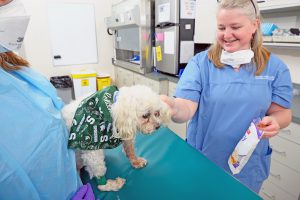
About Chemotheraphy
Chemotherapy is a regimen that uses chemical substances to reduce the symptoms and prolong the lives of cancer patients. Due to the nature of chemotherapy drugs, there can sometimes be vomiting, diarrhea, anorexia, or lethargy for a few days after treatment. Some drugs have more side effects than others. However, many of these effects can be controlled using other medications, and our goal is that your pet will maintain a very good appetite and excellent activity level, even while being treated with chemotherapy.
A side effect of chemotherapy is suppression of the immune system. With any chemotherapy protocol, we closely monitor the immune system and white blood cell count to ensure that your pet will still be able to fight off any infections. It will be very important for you to also monitor your pet at home and contact a member of our service for advice if any infections are seen. Our goal is to allow your pet to have a good quality of life for as long as possible.
VACCINES AND PREVENTATIVE CARE
In general, pets receiving chemotherapy can safely be vaccinated; however, the effectiveness of the vaccine is unknown. Many clients will decide to postpone vaccines until after the completion of a protocol, unless warranted for travel or boarding.
Routine flea and tick prevention, and heartworm medication, are strongly recommended as directed by your primary veterinarian.
Bathing and grooming your pet are fine unless otherwise directed.
SAFETY
Safety for your pet and our staff is taken seriously at Michigan State. Our staff uses a special unit (chemotherapy "hood") to protect against inhalation of any chemotherapy agents. A closed system administration unit is also used to maximize sterility and accuracy while minimizing contamination of the environment. Our staff wears personal protective devices, such as gowns, gloves, face shields, masks, and goggles, depending on the chemotherapy agent being administered. If you are going to be given chemotherapy at home, we will describe the measures you should take to protect yourself and your other pets.
Sedation: Most patients do not need to be sedated for their treatments and will be treated by at least two of our staff members gently restraining your pet. We will work with your pet to have the experience be enjoyable and to limit their stress. In certain situations, sedation for your pet may be the safest and least stressful way to administer a treatment. At the conclusion of the visit, we want your pet to be happy, comfortable, and most importantly, safe at our clinic.
